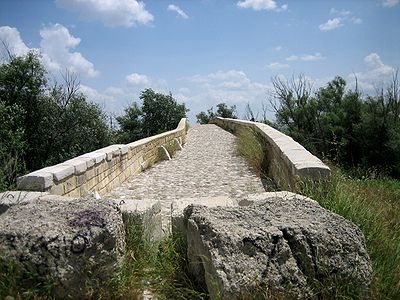CANOSA
Canosa is situated in a hilly
area above the Murge plateau. It is a city with ancient origins;
its foundation is linked to the mythical Homeric Greek hero,
Diomedes.
Archaeological searches, instead, have found that the territory
of Canosa was inhabited since Neolithic times (6.000-3.500
BC) and the Bronze Age (3.500-1.200 BC) as testified by the
Necropolis of Pozzillo.
Towards the 12th Century BC, a population of Lapigi arrived
from Illyria, now known as Albania, which saw the beginning
of three different cultures in Puglia: the Daunian, the Peucetians
and the Messapians.
It was the Daunii who founded the first settlement known as
Toppicelli, which is well documented by tombs rich with funerary
objects belonging to the supposed Princes.
Canosa became even more important and began to make commercial
deals with neighbouring Magno—Greek cities, which mediation
by Taranto and after the 4th Century BC, directly with the
interested cities.
Canosa entered into the political sphere of Rome in 318 BC,
but its rich inhabitants knew how to safeguard a favourable
agreement, which saved the City’s independence. In fact,
it continued to mint its own currency.
In 216 BC, Canosa welcomed the Romans who were defeated by
Hannibal in the Battle of Canne (Cannae), guaranteeing a healthy
future in war terms.
In ’86 BC, after the end of the Civil war, in which
Canosa lined up against Rome, the City became a municipium
and during the Imperial era, was added along the route of
Via Traiana (108 AD); a secondary arterial of Via Appia (Appian
Way), which connected Benevento and Brindisi.
During the second half of the II century AD, the City became
a colony by the name of Colonia Aurelia Augusta Pia Canusium.
It was in this period that the forum, amphitheatre, thermal
baths and a temple dedicated to Giove (Zeus) were built.
During the II century, it became an Episcopal seat, and after
a period of Barbaric invasions (4th Century AD) it experienced
a clash between the Ostrogoths and Byzantines during the Greek-Gothic
war (535-553 AD), when Canosa was made a stronghold.
During the 7th Century, Canosa entered as part of the Longobard
dominium, becoming a seat of Gastaldo, an administrative civil
employee of the Longobard Prince over his territory.
In the subsequent Century, it was Prince Arechi II /758-787)
who ordered construction of the Canosa Cathedral.
The decline of the Francos in Italy (774) and the arrival
of the Saracens (847-871), who had created an emirate in Bari
and had conquered Sicily, gave a blow to the economy of Canosa
and began its decay.
In ‘876, Puglia was reconquered by the Byzantines, but
their economic management soon provoked their discharge from
many cities in Puglia, which fused instead with the League
of Communes in Puglia, and thanks to the aid of Norman mercenaries,
obtained independence.
With the arrival of the Norman, Roberto Guiscard, who married
the Longobard “warrior princess”, Sichelgaita,
Puglia was freed entirely from Byzantine domination. Canosa,
however, although having entered into one the preferred metas
of Prince Boemondo of Altavilla, lost its importance in favour
of Bari, leading to its slow political and economic decline.
This continued under the Swabian lineage (13th Century).
The situation worsened over the centuries due to repeated
earthquakes (1361, 1456, 1627, 1659, 1851, 1930) which heavily
undermined the City’s economy.
It subsequently, as with many other cities in Southern Italy,
passed hands to the Angioini and then to the Aragonese, experiencing
the lordship of some of the most powerful noble families of
the time.
On 6th November 1943, Canosa was bombarded by the alliance
forces during fighting in the Second World War.
|
